Selecting Collections
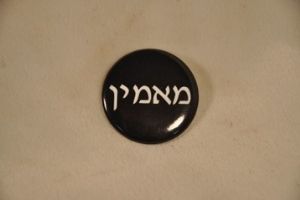
A blog post by Jobi Zink.
Here at the Jewish Museum of Maryland our collections comprise material culture artifacts, written documents and photographs owned by, made by, or used by Maryland Jews. As you can imagine, this is a vast and varied assortment of materials! We cannot possibly take everything that is offered to us, so the Collections Committee reviews each item offered to determine what is in good condition; has potential for exhibition, publication, or education program; has context or a story; balances the ordinary and the specific and personal.
As the Registrar, it’s my job to screen everything brought in. Many donations come in as people are downsizing, or cleaning up the attic. Sometimes people just can’t bear to throw anything away. I will flatly reject completely unidentified photographs—if the donor can’t tell me any bit of information, the photograph isn’t going to be useful to anyone else. Classified documents from the National Archives belong at the National Archives! Items with active mildew or requiring thousands of dollars of conservation services are generally declined.
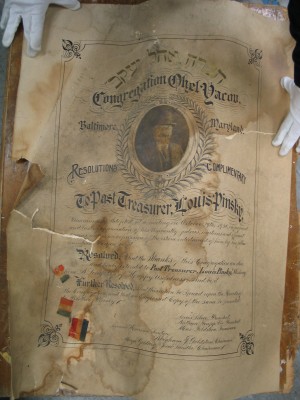
On the other hand, when the Jewish Times was moving their offices they offered us their photo collection dating back to the 1970s. Most of these photographs are identified by event, organization, and date, if not the individuals. While it will take us time to process everything, this is truly a treasure trove of documented Baltimore Jewish history!
Many artifacts come in as a direct result of a collecting initiative related to an exhibition. For example, when we were preparing for Ours to Fight For, an exhibition about the Jews who served during the second World War, we truly wanted a photograph of every single Jewish serviceman and servicewoman from Maryland. While we couldn’t house more uniforms, we certainly had room to recording first-person accounts, stories, and experiences. We now hope to expand our documentation to Maryland Jews serving in all other eras.
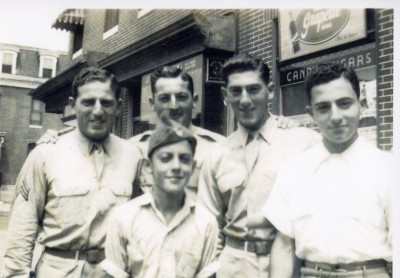
Just last week I had a call from a woman who wanted to donate her mother’s navy blue Neighborhood Watch uniform that she wore for patrol during air raids during World War II, along with her Red Cross certificates and a ration book. I was very interested in the item, as I hadn’t heard about neighborhood watches in Baltimore. Sadly, when I learned that the woman was from Northwest Pennsylvania I had to decline the gift.
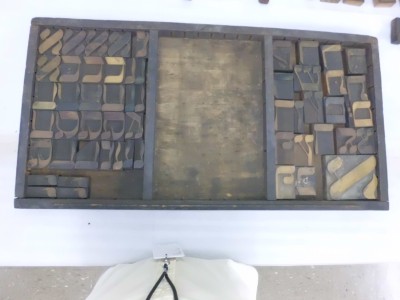 As anyone who has visited our Voices of Lombard Street exhibition could tell you, East Baltimore was once a predominantly Jewish neighborhood. Rabbi Herbert Kessler’s ledger, 1940, provides the family name and address of the circumcisions he performed in East Baltimore. In 2011 the Museum purchased 10 trays of Hebrew wood block type used by Romm Press, owned by Leon Romm in Baltimore, to print posters for Yiddish Theater in Baltimore until 1945.
As anyone who has visited our Voices of Lombard Street exhibition could tell you, East Baltimore was once a predominantly Jewish neighborhood. Rabbi Herbert Kessler’s ledger, 1940, provides the family name and address of the circumcisions he performed in East Baltimore. In 2011 the Museum purchased 10 trays of Hebrew wood block type used by Romm Press, owned by Leon Romm in Baltimore, to print posters for Yiddish Theater in Baltimore until 1945.
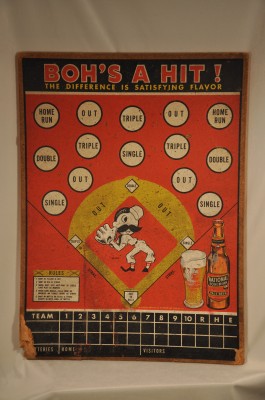 Baltimore has a rich history of breweries and brewmasters. The Hoffberger family owned National Brewing Company—and the Orioles! But we turned down an older, more historic bottle from the Gottlieb Baueren Schmidt Strauss Brewing company because it wasn’t Jewish-owned.
Baltimore has a rich history of breweries and brewmasters. The Hoffberger family owned National Brewing Company—and the Orioles! But we turned down an older, more historic bottle from the Gottlieb Baueren Schmidt Strauss Brewing company because it wasn’t Jewish-owned.
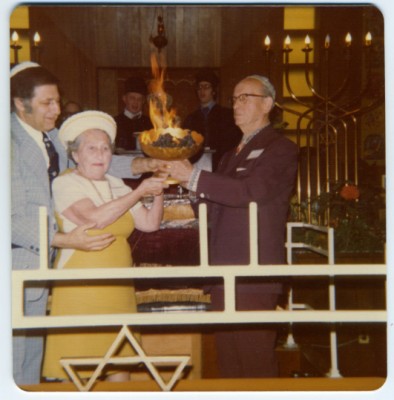 I do get very excited when we receive a trifecta—object, photograph, and document from a historic event. In 2010 we received the gold-colored vessel in which the Rogers Avenue Synagogue burned their mortgage in 1987 to accompany the program and photographs from the event
I do get very excited when we receive a trifecta—object, photograph, and document from a historic event. In 2010 we received the gold-colored vessel in which the Rogers Avenue Synagogue burned their mortgage in 1987 to accompany the program and photographs from the event
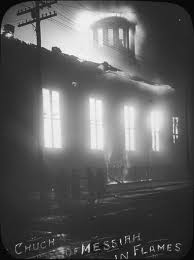 Several years ago, the Collections Committee decided that we have enough tallit, tallit bags, tefillin and tefillin bags in the collection and put a moratorium on collecting these items. However, when David and Zelda Schuman offered his grandfather’s tallis bag reportedly used for his bar mitzvah, held on February 8, 190 at the Russiche Shule (now B’nai Israel) with the story that the smoke and flames from the Great Baltimore fire could be seen, the committee made an exception!
Several years ago, the Collections Committee decided that we have enough tallit, tallit bags, tefillin and tefillin bags in the collection and put a moratorium on collecting these items. However, when David and Zelda Schuman offered his grandfather’s tallis bag reportedly used for his bar mitzvah, held on February 8, 190 at the Russiche Shule (now B’nai Israel) with the story that the smoke and flames from the Great Baltimore fire could be seen, the committee made an exception!
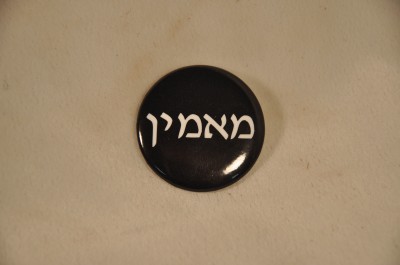 As this is President’s Day weekend, I thought I might close with items in our holdings at the intersection of the Jewish community and politics. One of the more surprising pieces of Judaica in our collection is a Kiddush cup engraved “T.R.Mc.K/ [Theodore R. McKeldin] Har Brook Hebrew Cong. June 24th, 1962.” While McKeldin certainly wasn’t Jewish, the Jews of Maryland were very fond of him. We also have a collection of tie tacks, and cufflinks given to him by various Jewish organizations. Other non-Jewish politicians are represented in our collection: Governor Bob Ehrlich wore a suede yarmulke at the Governor’s Chanukah party, Martin O’Malley appealed to Baltimore’s Jewish population during his “Believe” campaign with a pin in Hebrew, while Barack Obama had bumper stickers with his name on it
As this is President’s Day weekend, I thought I might close with items in our holdings at the intersection of the Jewish community and politics. One of the more surprising pieces of Judaica in our collection is a Kiddush cup engraved “T.R.Mc.K/ [Theodore R. McKeldin] Har Brook Hebrew Cong. June 24th, 1962.” While McKeldin certainly wasn’t Jewish, the Jews of Maryland were very fond of him. We also have a collection of tie tacks, and cufflinks given to him by various Jewish organizations. Other non-Jewish politicians are represented in our collection: Governor Bob Ehrlich wore a suede yarmulke at the Governor’s Chanukah party, Martin O’Malley appealed to Baltimore’s Jewish population during his “Believe” campaign with a pin in Hebrew, while Barack Obama had bumper stickers with his name on it
Only about 1% of our collections are included in any exhibition, but the JMM is proud to make our collections accessible via an online database (jmm.pastperfect-online.com). Please “tour” our collections to see what else we have!

1 reply on “Selecting Collections”
The Rogers Avenue Synagogue mortgage burning actually occurred in 1975, not 1987. Sorry for the confusion.